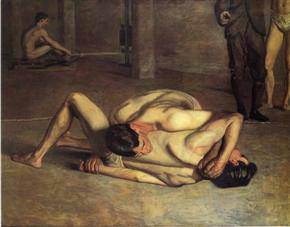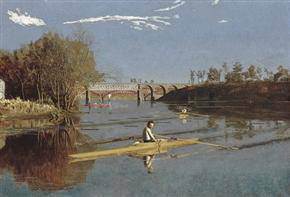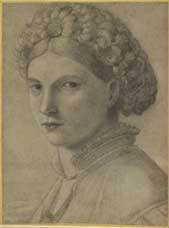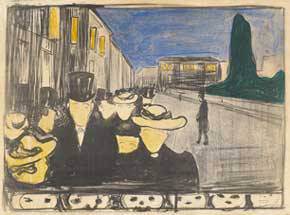
Thomas Eakins – Wrestlers, 1899

Thomas Eakins – The Champion
Single Sculls (Max Schmitt in a
Single Scull), 1871
Manly Pursuits: The Sporting Images of Thomas Eakins at the LACMA The Los Angeles County Museum of Art (LACMA) presents Manly Pursuits: The Sporting Images of Thomas Eakins, on view from July 25 to October 17, 2010]]>
Source: Los Angeles County Museum of Art (LACMA)
Manly Pursuits will be organized chronologically, from the 1870s to 1899,and thematically by type of physical endeavor.
1870s: Rowing, Sailing, Hunting and Coaching
Eakins began his career by depicting one of the activities he had missedwhile a student in Paris: rowing. His native Philadelphia was instrumentalin developing sculling into a modern competitive sport. Although sun andfresh air pervade these river scenes, Eakins recorded the races with theprecision and mathematical interest of a scientist. On view with theirrelated paintings will be the large-scale perspective drawings in which hecalculated the position of boats, oars, waves and even reflections.Eakins also sailed and hunted and was skillful with a rifle. After hecontracted malaria while hunting in one of the local marshes, he abandonedparticipating in the sport, and transferred his interest, instead, topainting it.
His most colorful and impressionistic scene, Fairman Rogers’ Four-in-Handwas the sole example Eakins devoted to the upper middle-class activity ofcoaching (the art of driving horse-drawn carriages). It also was perhapshis most controversial sporting canvas since in it he attempted to depictthe movement of the horses and wheels with photographic accuracy—animpulse many critics found to be at odds with the art of painting.
1880s: Swimming and Photography
At the end of the nineteenth century, swimming was deemed one of themost democratic of sports, especially in the United States, wheredoctors encouraged urban dwellers to maintain a healthy body throughexercise. Eakins devoted his sole sporting canvas of the 1880s tothis subject. Swimming (1884-85) was also one of the major paintingsin which he demonstrated his new interest in photography. On viewwill be photographs that helped Eakins compose the scene along withhis scientific studies of human anatomy and posture and hisexperimental motion photographs.
1890s: Boxing and Wrestling
Eakins’s last sporting images feature boxers and wrestlers andshowcase the new indoor spectator sports that attracted theattention of middle and working-class enthusiasts. These paintings,some of which rank among the artist’s largest canvases, areironically among his least known endeavors in the sporting genre.Boxing and wrestling imagery was typically modest in scale andrelegated to journalistic reports and advertising. But thesubstantial size of Eakins’s depictions elevated the sport to a newlevel of importance and its athletes to a new heroic stature.Remarkably, the three canvas versions of the Wrestlers paintings(two of which now belong to LACMA) have not been seen together sincethey left the artist’s studio over a century ago. The LACMAexhibition will historically reunite them. In addition, thewrestling paintings will be shown along with a group of relatedwrestling photographs that were recently discovered and have neverbefore been exhibited.
Follow us on:


